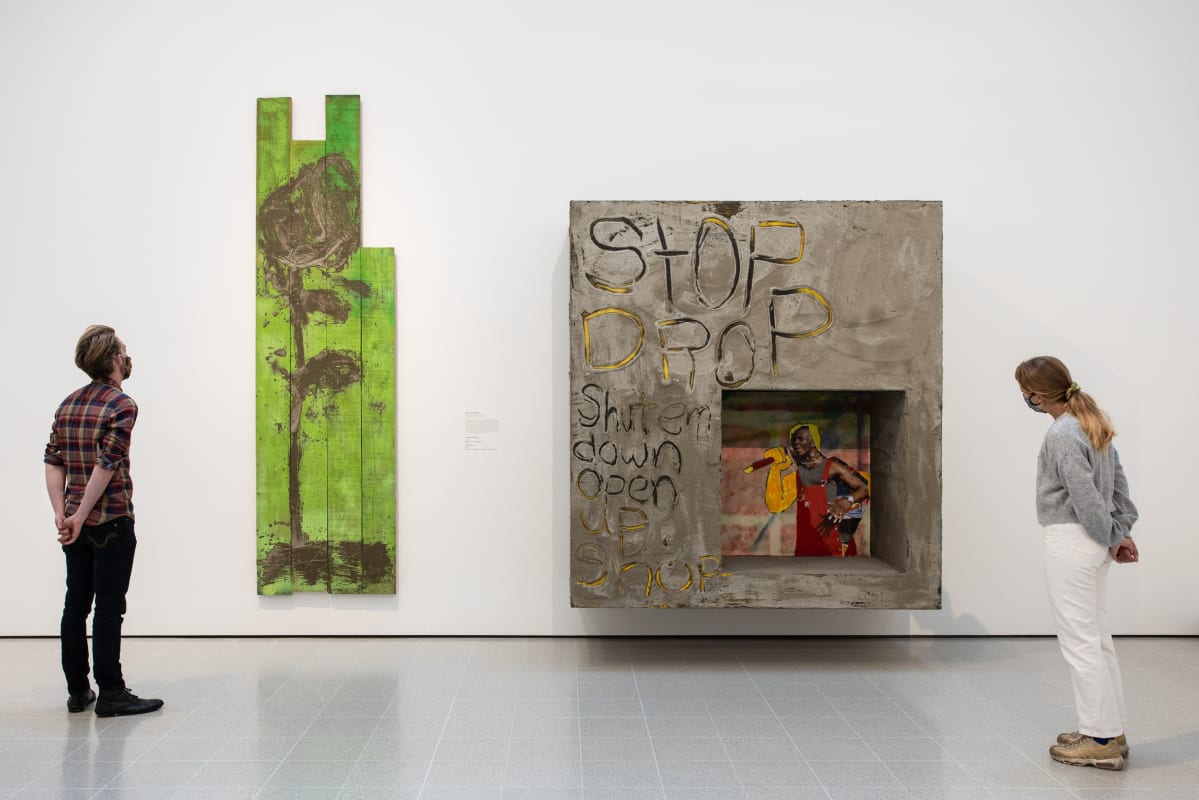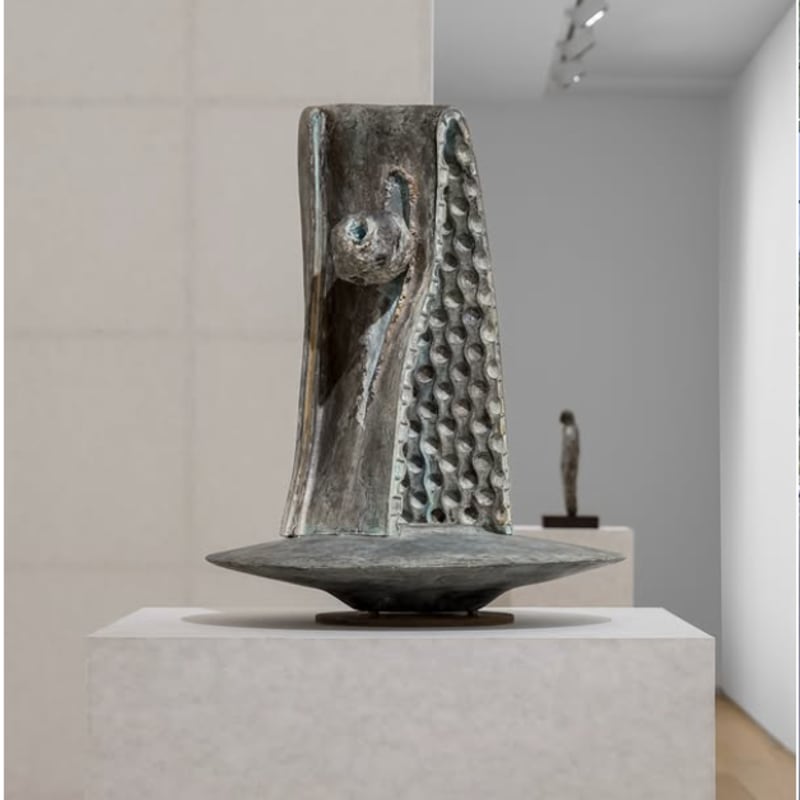Alvaro Barrington • Rachel Jones Mixing It Up: Painting Today review
'All of life is here. And it's too much!' - Mixing It Up: Painting Today review
by Adrian Searle
Hayward Gallery, London
Ghosts, fetish-wear, smokers, swimmers, monks, aubergines, birds, lots of cats … and Saddam Hussein. Our writer is overwhelmed by this attempt to survey contemporary painting
Paintings have people in them. There is always someone, somewhere, even in the most terse abstraction; the painter for a start, the viewers who look, and all the painters and commentators and viewers who came before. If we didn't already know what paintings were, we wouldn't know how to begin to look. There are 31 painters in the Hayward's Mixing It Up, subtitled Painting Today. What an uneven exhibition this is. Tightly hung and divided into seven sections or chapters, there is too much here to take on board in a single viewing. Painting is supposed to slow you down. It is impossible.
Here are paintings with cats, dogs, monkeys and cockerels in them. Paintings with Spitfires, stealth bombers, a painting of a room whose door is barricaded by a chair. A painting of a city in winter under a snowfall of rice. We move between paintings of shirts, curtains, venetian blinds, a fetish-wear raincoat and a transparent plastic mac, a fish on a dish, ghosts, apparitions, false memories and invented scenes. Paintings whose every touch and deviation and change of heart is exposed, and others where all effort is hidden and suppressed. Paintings that need big studios and assistants and others that require nothing much more than a table to work at and a sheet of paper. You tailor your needs to what's possible or plausible.
Paintings that reek of oil paint and others made with shampoo, laundry detergent and fabric softener. A lot of these artists don't appear to inhabit the same universe, let alone hold the same historical perspective. How could they? Painters of colour, queer painters, women painters - everyone interrogates history differently, and anyone who decides to paint has already been colonised by history, and attempts to reclaim space for themselves. In a series of parodic black female nudes, which run the gamut between academicism and the kitschy, the cartoonish and the confrontational, Somaya Critchlow faces the viewer down.
Her figures morph as we look, in a kind of salacious undoing of their conventions. Black subjects, colonised subjects, queer subjects, post-internet subjects - everything is given but nothing can be taken for granted or at face value. Beginning again means reckoning with the past. That said, as well as the urgent and the unexpected, there are the niche, the minor, and sometimes the plain silly here. Sometimes here it is hard to tell which is which. There's more than one way to skin, let alone paint, a cat. And there are plenty of cats.
Paintings of painters and painter's models and paintings of paintings. Painted smokers, swimmers, moonbathers on a beach, rapper DMX, whose life and death were frightening and tragic, memorialised by Alvaro Barrington. Reality crashes in and stops you dead. Paintings of aubergines that are also delicious little cocks, caught in trompe-l'oeil relief, and paintings of teeth that look like luxuriant gardens of post-impressionist abstraction. Nothing is quite what it appears.
I keep finding things that lurk, half seen or barely intimated. Saddam Hussein, whose absent presence haunts the work of Mohammed Sami, who painted that chair that blocks the door. Behind another door, a woman smoking. A rubbery shadow slithering in the bedroom, lingering in the frowzy night over a woman's corpse in one of Caroline Coon's most memorable images. Sometimes a single artist can belay you with the discordancy of their images. In Louise Giovanelli's small paintings, we go back and forth from sheer curtains to shiny shirts, a tonsured monk to a torch singer whose knife-like nails wrap around the microphone in the spangled gloom, and Tippi Hedren pursued by the birds in Hitchcock's movie.
Paintings with singers in them, paintings that must've been noisy to make. Paintings by Issy Wood, which are as woozy and as enigmatic as Wood's pop records and music videos. Paintings by Denzil Forrester, noisy with police sirens and street life and juddering to sound-system dub. Paintings with guitars and paintings of silent blue nocturnal gloom made to the music of Miles Davis, in Andrew Pierre Hart's moody and elusive canvases. Paintings that quote other paintings and paintings that take you for a ride; painting constantly changes and always stays the same.
It is not, perhaps, the time to rehash painting's timeliness or belatedness. There is no need for a defence. We might worry that we fetishise the physical, but we live in physical space, and the differences in touch, materiality and scale really do matter in a painting, however discrete or immaterial or lumpy, vibrant (and even smelly) it might be. How we read paintings depends on our time and place, the things we already know as well as the things the artwork (distinct from the one who made it), might be telling us. Oscar Murillo's manifestation paintings might lumber in, with their frenetically reworked and overworked, toiled at and maimed surfaces, but their aggressive walls of muck and overt physicality are a kind of anti-expressionism; more like paintings that are churning and eating themselves up than heroic struggles with the inchoate. Their masculinity is a kind of brawling impotence, their resolutions only ever a contingency. In their way they're no more or less academic than Merlin James's thoughtful little compositions that hang nearby. Their rhetoric is simply played out in a different register.
Laughable paintings and painting for a laugh: sometimes I try too hard to find connections. Is the cat flap in one of Lydia Blakeley's works, with the moggie emerging through it, meant to allude to Malevich's suprematist Black Square, or is it me? The multiple life models trapped in Lisa Brice's invented studio chat and wait and move canvases around, pour paint and speak on their phones, and all of them smoking in the lassitude of evening. No longer muses or models or whatever else some male painter might once have wanted them to be, they are currently unavailable and doing their own stuff. There are cats here too, slinking about, and the studio is an entirely female space.
Painting never was killed by printing, photography, film or any other medium. Nor was it killed by theory, by conceptual art or anything else. It persists both because of and despite its long history. Which is why it is so rich, so difficult, and at times so compelling. At a panel discussion on a painting show I curated with Greg Hilty at the Hayward in the mid 1990s, the Portuguese painter Julião Sarmento, who passed away this summer, said "So painting is dead? Good. It means we can do what we want."
Mixing it Up: Painting Today is at the Hayward Gallery, London, from 9 September to 12 December.


















































































































































































